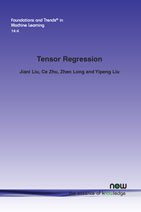Tensor Regression
By Jiani Liu, University of Electronic Science and Technology of China, China, jianiliu@std.uestc.edu.cn | Ce Zhu, University of Electronic Science and Technology of China, China, eczhu@uestc.edu.cn | Zhen Long, University of Electronic Science and Technology of China, China, zhenlong@std.uestc.edu.cn | Yipeng Liu, University of Electronic Science and Technology of China, China, yipengliu@uestc.edu.cn
Abstract
The presence of multidirectional correlations in emerging multidimensional data poses a challenge to traditional regression modeling methods. Traditional modeling methods based on matrix or vector, for example, not only overlook the data’s multidimensional information and lower model performance, but also add additional computations and storage requirements. Driven by the recent advances in applied mathematics, tensor regression has been widely used and proven effective in many fields, such as sociology, climatology, geography, economics, computer vision, chemometrics, and neuroscience. Tensor regression can explore multidirectional relatedness, reduce the number of model parameters and improve model robustness and efficiency. It is timely and valuable to summarize the developments of tensor regression in recent years and discuss promising future directions, which will help accelerate the research process of tensor regression, broaden the research direction, and provide tutorials for researchers interested in high dimensional regression tasks.
The fundamentals, motivations, popular algorithms, related applications, available datasets, and software resources for tensor regression are all covered in this monograph. The first part focuses on the key concepts for tensor regression, mainly analyzing existing tensor regression algorithms from the perspective of regression families. Meanwhile, the adopted low rank tensor representations and optimization frameworks are also summarized. In addition, several extensions in online learning and sketching are described. The second part covers related applications, widely used public datasets and software resources, as well as some real-world examples, such as multitask learning, spatiotemporal learning, human motion analysis, facial image analysis, neuroimaging analysis (disease diagnosis, neuron decoding, brain activation, and connectivity analysis) and chemometrics. This survey can be used as a basic reference in tensor-regression-related fields and assist readers in efficiently dealing with high dimensional regression tasks.
Tensor Regression
Regression analysis is a key area of interest in the field of data analysis and machine learning which is devoted to exploring the dependencies between variables, often using vectors. The emergence of high dimensional data in technologies such as neuroimaging, computer vision, climatology and social networks, has brought challenges to traditional data representation methods. Tensors, as high dimensional extensions of vectors, are considered as natural representations of high dimensional data.
In this book, the authors provide a systematic study and analysis of tensor-based regression models and their applications in recent years. It groups and illustrates the existing tensor-based regression methods and covers the basics, core ideas, and theoretical characteristics of most tensor-based regression methods. In addition, readers can learn how to use existing tensor-based regression methods to solve specific regression tasks with multiway data, what datasets can be selected, and what software packages are available to start related work as soon as possible.
Tensor Regression is the first thorough overview of the fundamentals, motivations, popular algorithms, strategies for efficient implementation, related applications, available datasets, and software resources for tensor-based regression analysis. It is essential reading for all students, researchers and practitioners of working on high dimensional data.
